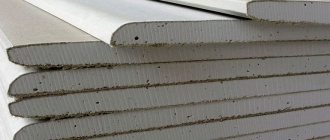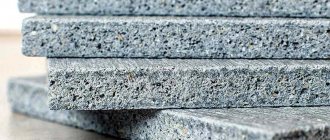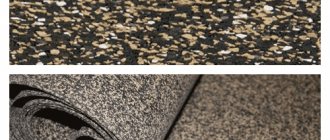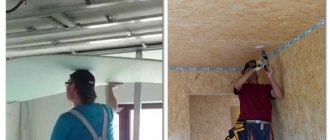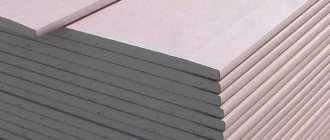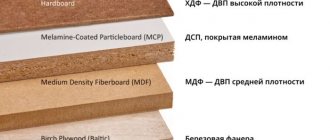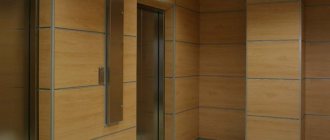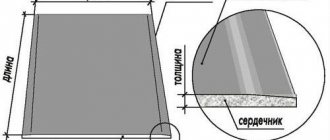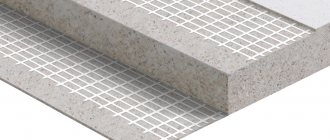Table of thermal conductivity of materials on Pli-
| Material | Density, kg/m3 | Thermal conductivity, W/(m deg) | Heat capacity, J/(kg deg) |
| Pressed paper plate | 600 | 0.07 | — |
| Cork plate | 80…500 | 0.043…0.055 | 1850 |
| Facing tiles, tiles | 2000 | 1.05 | — |
| Thermal insulation tile PMTB-2 | — | 0.04 | — |
| Alabaster slabs | — | 0.47 | 750 |
| Gypsum slabs GOST 6428 | 1000…1200 | 0.23…0.35 | 840 |
| Wood-fiber and particle boards (GOST 4598-74, GOST 10632-77) | 200…1000 | 0.06…0.15 | 2300 |
| Slabs made of expanded clay concrete | 400…600 | 0.23 | — |
| Polystyrene concrete slabs GOST R 51263-99 | 200…300 | 0.082 | — |
| Resol-formaldehyde foam boards (GOST 20916-75) | 40…100 | 0.038…0.047 | 1680 |
| Plates made of glass staple fiber with a synthetic binder (GOST 10499-78) | 50 | 0.056 | 840 |
| Slabs made of cellular concrete GOST 5742-76 | 350…400 | 0.093…0.104 | — |
| Reed slabs | 200…300 | 0.06…0.07 | 2300 |
| Silica slabs | 0.07 | — | |
| Flax insulating slabs | 250 | 0.054 | 2300 |
| Mineral wool slabs with bitumen binder grade 200 GOST 10140-80 | 150…200 | 0.058 | — |
| Mineral wool slabs with synthetic binder grade 200 GOST 9573-96 | 225 | 0.054 | — |
| Mineral wool slabs with synthetic bond (Finland) | 170…230 | 0.042…0.044 | — |
| Mineral wool slabs of increased rigidity GOST 22950-95 | 200 | 0.052 | 840 |
| Mineral wool slabs of increased rigidity with an organophosphate binder (TU 21-RSFSR-3-72-76) | 200 | 0.064 | 840 |
| Semi-rigid mineral wool slabs with starch binder | 125…200 | 0.056…0.07 | 840 |
| Mineral wool slabs with synthetic and bitumen binders | — | 0.048…0.091 | — |
| Soft, semi-rigid and hard mineral wool slabs with synthetic and bitumen binders (GOST 9573-82, GOST 10140-80, GOST 12394-66) | 50…350 | 0.048…0.091 | 840 |
| Foam plastic boards based on resol phenol-formaldehyde resins GOST 20916-87 | 80…100 | 0.045 | — |
| Expanded polystyrene boards GOST 15588-86 without pressing | 30…35 | 0.038 | — |
| Polystyrene foam plates (extrusion) TU 2244-001-47547616-00 | 32 | 0.029 | — |
| Perlite-bitumen slabs GOST 16136-80 | 300 | 0.087 | — |
| Perlite-fiber slabs | 150 | 0.05 | — |
| Perlite-phosphogel slabs GOST 21500-76 | 250 | 0.076 | — |
| Perlito-1 slabs Plastic concrete TU 480-1-145-74 | 150 | 0.044 | — |
| Perlite cement slabs | — | 0.08 | — |
| Construction slabs made of porous concrete | 500…800 | 0.22…0.29 | — |
| Thermobitumen thermal insulation slabs | 200…300 | 0.065…0.075 | — |
| Peat thermal insulation slabs (GOST 4861-74) | 200…300 | 0.052…0.064 | 2300 |
| Fiberboard slabs (GOST 8928-81) and wood concrete (GOST 19222-84) on Portland cement | 300…800 | 0.07…0.16 | 2300 |
Main parameters
What is the thermal conductivity of building materials table
? The quality of a material can be assessed based on several fundamental characteristics. The first of these is the thermal conductivity coefficient, which is denoted by the symbol “lambda” (ι). This coefficient shows how much heat passes through a piece of material 1 meter thick and 1 m² in area in 1 hour, provided that the difference between the ambient temperatures on both surfaces is 10°C.
The thermal conductivity of any insulation depends on many factors - humidity, vapor permeability, heat capacity, porosity and other characteristics of the material.
Sensitivity to moisture
Humidity is the amount of moisture contained in the insulation. Water conducts heat well, and a surface saturated with it will help cool the room. Consequently, an over-moistened thermal insulation material will lose its qualities and will not give the desired effect. And vice versa: the more water-repellent properties it has, the better.
Vapor permeability is a parameter close to humidity. In numerical terms, it represents the volume of water vapor passing through 1 m2 of insulation in 1 hour, subject to the condition that the difference in potential vapor pressure is 1 Pa and the temperature of the medium is the same.
Water absorption is the ability of a product to absorb liquid when it comes into contact. The water absorption coefficient is very important for materials that are used for external thermal insulation. Increased air humidity, precipitation and dew can lead to a deterioration in the characteristics of the material.
It is also not recommended to use water-absorbing insulation when finishing bathrooms, toilets, kitchens and other rooms with high levels of humidity.
Density and heat capacity
Porosity is the number of air pores expressed as a percentage of the total volume of the product. There are closed and open pores, large and small
It is important that they are distributed evenly in the structure of the material: this indicates the quality of the product. Porosity can sometimes reach 50%; in the case of some types of cellular plastics this figure is 90-98%
Density is one of the characteristics that affects the mass of a material. A special table will help you determine both of these parameters. Knowing the density, you can calculate how much the load on the walls of the house or its ceiling will increase.
Heat capacity is an indicator demonstrating how much heat the insulation is ready to accumulate. Biostability is the ability of a material to resist the effects of biological factors, for example, pathogenic flora. Fire resistance is resistance to fire insulation, and this parameter should not be confused with fire safety. There are also other characteristics, which include strength, bending endurance, frost resistance, and wear resistance.
Resistance coefficient
Also, when performing calculations, you need to know the coefficient U - the resistance of structures to heat transfer. This indicator has nothing to do with the qualities of the materials themselves, but you need to know it in order to make the right choice among a variety of insulation materials. The U-factor is the ratio of the temperature difference on the two sides of the insulation to the volume of heat flow passing through it. To find the thermal resistance of walls and ceilings, you need a table that calculates the thermal conductivity of building materials.
You can make the necessary calculations yourself. To do this, the thickness of the material layer is divided by its thermal conductivity coefficient. The last parameter - if we are talking about insulation - should be indicated on the packaging of the material. In the case of house structural elements, everything is a little more complicated: although their thickness can be measured independently, the thermal conductivity coefficient of concrete, wood or brick will have to be looked up in specialized manuals.
Types, their comparison and properties
Drywall is a multi-layer board of paper and gypsum. This design allows the material to be used as finishing, as well as to create interior partitions from it. If you follow certain rules during installation, you can hang shelves on the walls and glue wallpaper.
But the thermal conductivity of drywall is not the only indicator that should be used as a guide when choosing canvases. It is important to pay attention to the types of material. He can be:
- standard;
- fire resistant;
- moisture resistant;
- fire and moisture resistant.
When you visit the store, you will see Knauf plasterboard, the thermal conductivity coefficient of which is the lowest among other varieties. In addition, this material is offered for sale in the “super sheet” variety. It has a fibrous structure, which improves the properties of sheets, facilitates the cutting process and increases strength. Supersheet is convenient for installing interior partitions.
In general, the thermal conductivity of drywall is not the only characteristic that you should pay attention to. You must choose from a variety of canvas options, including:
- acoustic
- arched;
- vinyl.
For example, arched cardboard has less thickness and weight, which allows you to create curved, complex structures. When using vinyl, you will feel that the material is easy to work with, because its surface is ready for decorative finishing and does not require putty.
The thermal conductivity of drywall was mentioned above, but you should also know about other properties of plasterboard, including:
- safety;
- smoothness;
- ease of processing;
- high noise insulation characteristics;
- low cost;
- relatively light weight;
- mechanical strength;
- environmental friendliness.
Fourier's law of thermal conductivity
Thermal conductivity of building materials
In steady state, the energy flux density transmitted through thermal conductivity is proportional to the temperature gradient:
q→=−ϰgrad(T),{\displaystyle {\vec {q}}=-\varkappa \,\mathrm {grad} (T),}
where q→{\displaystyle {\vec {q}}} is the heat flux density vector—the amount of energy passing per unit time through a unit area perpendicular to each axis, ϰ{\displaystyle \varkappa }—the thermal conductivity coefficient
(specific thermal conductivity), T{\displaystyle T} - temperature.
The minus on the right side shows that the heat flow is directed opposite to the vector grad(T){\displaystyle \mathrm {grad} (T)} (that is, in the direction of the fastest decrease in temperature). This expression is known as Fourier's
law of heat conduction .
In integral form, the same expression will be written as follows (if we are talking about a stationary heat flow from one side of the parallelepiped to the other):
P=−ϰSΔTl,{\displaystyle P=-\varkappa {\frac {S\Delta T}{l}},} [W/(m K) (m2 K)/m = W/(m K) (m K) = W]
where P{\displaystyle P} is the total power of heat loss, S{\displaystyle S} is the cross-sectional area of the parallelepiped, ΔT{\displaystyle \Delta T} is the temperature difference between the faces, l{\displaystyle l} is the length of the parallelepiped, that is, the distance between edges.
Connection with electrical conductivity
The connection between the thermal conductivity coefficient ϰ{\displaystyle \varkappa } and the electrical conductivity σ{\displaystyle \sigma } in metals is established by the Wiedemann-Franz law:
ϰσ=π23(ke)2T,{\displaystyle {\frac {\varkappa }{\sigma }}={\frac {\pi ^{2}}{3}}\left({\frac {k}{e }}\right)^{2}T,} where k{\displaystyle k} is Boltzmann’s constant; e{\displaystyle e}—electron charge; T{\displaystyle T} is the absolute temperature.
Thermal conductivity coefficient of gases
In gases, the thermal conductivity coefficient can be found using the approximate formula
ϰ∼13ρcvλv¯,{\displaystyle \varkappa \sim {\frac {1}{3}}\rho c_{v}\lambda {\bar {v}},}
where ρ{\displaystyle \rho } is the gas density, cv{\displaystyle c_{v}} is the specific heat capacity at constant volume, λ{\displaystyle \lambda } is the mean free path of gas molecules, v¯{\displaystyle {\ bar {v}}} — average thermal speed. The same formula can be written as
ϰ=ik3π32d2RTμ,{\displaystyle \varkappa ={\frac {ik}{3\pi ^{3/2}d^{2}}}{\sqrt {\frac {RT}{\mu }}},}
where i{\displaystyle i} is the sum of the translational and rotational degrees of freedom of molecules (for a diatomic gas i=5{\displaystyle i=5}, for a monatomic gas i=3{\displaystyle i=3}), k{\displaystyle k} is the Boltzmann constant, μ{\displaystyle \mu } is the molar mass, T{\displaystyle T} is the absolute temperature, d{\displaystyle d} is the effective (gas-kinetic) diameter of the molecules, R{\displaystyle R} is the universal gas constant. From the formula it is clear that heavy monatomic (inert) gases have the lowest thermal conductivity, and light polyatomic gases have the highest (which is confirmed by practice, the maximum thermal conductivity of all gases is hydrogen, the minimum is radon, and of non-radioactive gases is xenon).
Thermal conductivity in highly rarefied gases
The above expression for the coefficient of thermal conductivity in gases does not depend on pressure. However, if the gas is very rarefied, then the mean free path is determined not by the collisions of molecules with each other, but by their collisions with the walls of the container. The state of a gas in which the free path of molecules is limited by the dimensions of the vessel is called high vacuum.
. At high vacuum, thermal conductivity decreases in proportion to the density of the substance (that is, proportional to the pressure in the system): ϰ∼13ρcvlv¯∝P{\displaystyle \varkappa \sim {\frac {1}{3}}\rho c_{v}l{\bar {v}}\propto P}, where l{\displaystyle l} is the size of the vessel, P{\displaystyle P} is the pressure.
Thus, the thermal conductivity coefficient of vacuum is closer to zero, the deeper the vacuum. This is due to the low concentration in vacuum of material particles capable of transferring heat. However, energy in a vacuum is transferred through radiation. Therefore, for example, to reduce heat loss, the walls of a thermos are made double, silvered (such a surface reflects radiation better), and the air between them is pumped out.
Indicator table
SML panels: a modern and multifunctional analogue of drywall
For ease of work, the thermal conductivity coefficient of the material is usually entered into the table. In addition to the coefficient itself, it can reflect such indicators as the degree of humidity, density and others. Materials with high thermal conductivity are combined in the table with indicators of low thermal conductivity. A sample of this table is shown below:
Using the thermal conductivity coefficient of the material will allow you to build the desired building. The main thing: choose a product that meets all the necessary requirements. Then the building will be comfortable for living; it will maintain a favorable microclimate.
A properly selected one will reduce heat loss, so there will no longer be a need to “heat the street.” Thanks to this, financial heating costs will be significantly reduced. Such savings will allow you to soon return all the money that will be spent on purchasing a heat insulator.
What is thermal conductivity? Not only professional builders need to know about this value, but also ordinary people who decide to build a house on their own.
Each material used in construction has its own indicator of this value. Its lowest value is for insulation materials, the highest for metals. Therefore, you need to know the formula that will help calculate the thickness of both the walls being built and the thermal insulation in order to ultimately get a cozy home.
Additional properties: disadvantages and advantages
Among the positive properties of plasterboard, one should highlight high bending strength, poor flammability, the ability to withstand low temperatures, high thermal conductivity, environmental friendliness, low weight, and ease of installation. This material also has its drawbacks, namely poor moisture resistance, fragility during transportation and installation, as well as insufficient strength. In addition, without a frame, the sheets are quite difficult to install.
As for bending strength, we can say about this property that a square meter of canvas can withstand up to 15 kg of load with a thickness of 1 cm. A rather important characteristic is also poor flammability. It is provided with a gypsum base. The material is poorly flammable and belongs to group G1 for flammability and B2 for flammability.
The material withstands low temperatures well. In the cold it does not crack or burst, but if the temperature rises, its physical properties are restored. It is impossible not to mention the thermal conductivity coefficient. The canvas regulates the level of humidity, which is especially true for gypsum boards.
Thermal conductivity of materials. Table
Very often, a home craftsman has to choose which material to choose for a particular job. One of the main parameters of materials, including construction ones, is their thermal conductivity.
To quickly find the answer to what thermal conductivity a particular material has, or to compare different materials, it is very convenient to use the table of thermal conductivity of materials.
Of course, not all materials are collected in the table. But for most of the most common materials, you can find the thermal conductivity value in it.
| Density (for bulk - bulk density), kg/m3 | Thermal conductivity coefficient, W/ (m*K) | |
| Aluminum | 2600-2700 | 203.5-221 increases with increasing density |
| Asbestos | 600 | 0,151 |
| Asphalt concrete | 2100 | 1,05 |
| ADC asbestos-cement slabs | 1800 | 0,35 |
| Concrete see also Reinforced concrete | 2300-2400 | 1.28-1.51 increases with increasing density |
| Bitumen | 1400 | 0,27 |
| Bronze | 8000 | 64 |
| Viniplast | 1380 | 0,163 |
| Water at temperatures above 0 degrees C | ~1000 | ~0,6 |
| Woolen felt | 300 | 0,047 |
| Drywall | 800 | 0,15 |
| Granite | 2800 | 3,49 |
| Wood, oak - along the grain | 700 | 0,23 |
| Wood, oak - across the grain | 700 | 0,1 |
| Wood, pine or spruce - along the grain | 500 | 0,18 |
| Wood, pine or spruce - across the grain | 500 | 0.10–0.15 increases with increasing density and humidity |
| Chipboard, OSB; wood or oriented strand board | 1000 | 0,15 |
| Reinforced concrete | 2500 | 1,69 |
| Cardboard facing | 1000 | 0,18 |
| Expanded clay | 200 | 0,1 |
| Expanded clay | 800 | 0,18 |
| Expanded clay concrete | 1800 | 0,66 |
| Expanded clay concrete | 500 | 0,14 |
| Ceramic hollow brick (gross 1000) | 1200 | 0,35 |
| Ceramic hollow brick (gross 1400) | 1600 | 0,41 |
| Red clay brick | 1800 | 0,56 |
| Brick, silicate | 1800 | 0,7 |
| Insulating brick masonry | 600 | 0.116–0.209 increases with increasing density |
| Ordinary brickwork | 600–1700 | 0.384—0.698—0.814 increases with increasing density |
| Fire brick masonry | 1840 | 1.05 (at 800-1100°C) |
| Oil paint | — | 0,233 |
| Brass | 8500 | 93 |
| Ice at temperatures below 0 degrees C | 920 | 2,33 |
| Linoleum | 1600 | 0,33 |
| Stone casting | 3000 | 0,698 |
| Magnesia 85% powder | 216 | 0,07 |
| Copper | 8500-8800 | 384-407 increases with increasing density |
| Minvata | 100 | 0,056 |
| Minvata | 50 | 0,048 |
| Minvata | 200 | 0,07 |
| Marble | 2800 | 2,91 |
| Scale, water stone | — | 1.163—3.49 increases with increasing density |
| Wood sawdust | 230 | 0.070–0.093 increases with increasing density and humidity |
| Dry tow | 150 | 0,05 |
| Foam concrete | 1000 | 0,29 |
| Foam concrete | 300 | 0,08 |
| Styrofoam | 30 | 0,047 |
| PVC foam | 125 | 0,052 |
| Expanded polystyrene | 100 | 0,041 |
| Expanded polystyrene | 150 | 0,05 |
| Expanded polystyrene | 40 | 0,038 |
| Extruded polystyrene foam | 33 | 0,031 |
| Polyurethane foam | 32 | 0,023 |
| Polyurethane foam | 40 | 0,029 |
| Polyurethane foam | 60 | 0,035 |
| Polyurethane foam | 80 | 0,041 |
| Foam glass | 400 | 0,11 |
| Foam glass | 200 | 0,07 |
| Sand dry | 1600 | 0,35 |
| Wet sand | 1900 | 0,814 |
| Polyurea | 1100 | 0,21 |
| Polyurethane mastic | 1400 | 0,25 |
| Polyethylene | 1500 | 0,3 |
| Cork fines | 160 | 0,047 |
| Rust (scale) | — | 1,16 |
| Ruberoid, glassine | 600 | 0,17 |
| Lead | 11400 | 34,9 |
| Sovelit | 450 | 0,098 |
| Steel | 7850 | 58 |
| Stainless steel | 7900 | 17,5 |
| Window glass | 2500 | 0,698—0,814 |
| Glass wool (glass wool) | 200 | 0.035–0.070 increases with increasing density |
| Textolite | 1380 | 0,244 |
| Peat slabs | 220 | 0,064 |
| Plywood | 600 | 0,12 |
| Faolite | 1730 | 0,419 |
| Cast iron | 7500 | 46,5—93,0 |
| Slag wool | 250 | 0,076 |
| Enamel | 2350 | 0,872—1,163 |
“Types of heat transfer: thermal conductivity, convection, radiation”
Heat transfer is a way of changing the internal energy of a body by transferring energy from one part of the body to another or from one body to another without doing work. The following types of heat transfer exist: conduction, convection and radiation.
Thermal conductivity
Thermal conduction is the process of transferring energy from one body to another or from one part of a body to another due to the thermal movement of particles
It is important that during thermal conduction there is no movement of matter; energy is transferred from one body to another or from one part of the body to another
Different substances have different thermal conductivities. If you put a piece of ice at the bottom of a test tube filled with water and place its upper end over the flame of an alcohol lamp, then after a while the water in the upper part of the test tube will boil, but the ice will not melt. Consequently, water, like all liquids, has poor thermal conductivity.
Gases have even poorer thermal conductivity. Let's take a test tube containing nothing but air, and place it over the flame of an alcohol lamp. A finger placed in a test tube will not feel any heat. Consequently, air and other gases have poor thermal conductivity.
Metals are good conductors of heat, while highly rarefied gases are the worst. This is explained by the peculiarities of their structure. Molecules of gases are located at distances from each other that are greater than molecules of solids, and collide much less frequently. Therefore, the transfer of energy from one molecules to others in gases does not occur as intensely as in solids. The thermal conductivity of a liquid is intermediate between the thermal conductivity of gases and solids.
Convection
As is known, gases and liquids conduct heat poorly. At the same time, the air is heated from steam heating batteries. This occurs due to a type of thermal conductivity called convection.
If a pinwheel made of paper is placed over a heat source, the pinwheel will begin to rotate. This happens because the heated, less dense layers of air rise upward under the action of the buoyant force, and the colder ones move down and take their place, which leads to the rotation of the turntable.
Convection is a type of heat transfer in which energy is transferred through layers of liquid or gas. Convection is associated with the transfer of matter, so it can only occur in liquids and gases; Convection does not occur in solids.
Radiation
The third type of heat transfer is radiation. If you bring your hand to the coil of an electric stove plugged in, to a burning light bulb, to a heated iron, to a radiator, etc., you can clearly feel the heat.
Experiments also show that black bodies absorb and emit energy well, while white or shiny bodies emit and absorb it poorly. They reflect energy well. Therefore, it is understandable why people wear light-colored clothes in the summer, and why they prefer to paint houses in the south white.
By radiation, energy is transferred from the Sun to the Earth. Since the space between the Sun and the Earth is a vacuum (the height of the Earth’s atmosphere is much less than the distance from it to the Sun), energy cannot be transferred either by convection or by thermal conduction. Thus, the transfer of energy by radiation does not require the presence of any medium; this heat transfer can also be carried out in a vacuum.
Lesson summary “Types of heat transfer: thermal conductivity, convection, radiation.”
Next topic: “Amount of heat. Specific heat".
The concept of thermal conductivity in practice
Thermal conductivity is taken into account at the building design stage
In this case, the ability of materials to retain heat is taken into account. Thanks to their correct selection, residents will always feel comfortable indoors
During operation, heating costs will be significantly saved.
Insulation at the design stage is the optimal, but not the only solution. It is not difficult to insulate an already finished building by carrying out internal or external work. The thickness of the insulation layer will depend on the materials chosen. Some of them (for example, wood, foam concrete) can in some cases be used without an additional layer of thermal insulation. The main thing is that their thickness exceeds 50 centimeters.
Particular attention should be paid to the insulation of the roof, window and door openings, and floors. The most heat is lost through these elements
This can be seen visually in the photograph at the beginning of the article.
Insulated gypsum boards
Recently, a new material has appeared on the market - “warm drywall” . It is available in several types. The insulation is glued to one sheet of gypsum board or fixed between two. Used for both external and internal work. The thickness of slabs with one layer reaches 60 mm, double-layer up to 100 mm, size 1200 x 2500 mm. Main scope of application: prefabricated structures, summer country houses, utility rooms. Inside buildings it is glued to the walls. Polystyrene is often used as insulation; the thickness of the layer varies depending on its width. The main advantage of the material is low thermal conductivity and high installation speed.
Double plasterboard with insulation
The low thermal conductivity of gypsum board sheets is another additional advantage of the material, which makes it in demand in the construction market.
Watch the video: properties of insulation for drywall
Coefficient of thermal conductivity.
The amount of heat that passes through the walls (and according to science, the intensity of heat transfer due to thermal conductivity) depends on the temperature difference (in the house and outside), on the area of the walls and the thermal conductivity of the material from which these walls are made.
To quantify thermal conductivity, there is a coefficient of thermal conductivity of materials. This coefficient reflects the property of a substance to conduct thermal energy. The higher the thermal conductivity coefficient of a material, the better it conducts heat. If we are going to insulate a house, then we need to choose materials with a small value of this coefficient. The smaller it is, the better. Nowadays, the most widely used materials for insulating buildings are mineral wool insulation and various foam plastics. A new material with improved thermal insulation properties – Neopor – is gaining popularity.
The thermal conductivity coefficient of materials is designated by the letter? (Greek small letter lambda) and is expressed in W/(m2*K). This means that if we take a brick wall with a thermal conductivity coefficient of 0.67 W/(m2*K), a thickness of 1 meter and an area of 1 m2, then with a temperature difference of 1 degree, 0.67 watts of thermal energy will pass through the wall energy. If the temperature difference is 10 degrees, then 6.7 watts will pass. And if, with such a temperature difference, the wall is made 10 cm, then the heat loss will already be 67 watts. More details about the methodology for calculating heat loss in buildings can be found here.
It should be noted that the values of the thermal conductivity coefficient of materials are indicated for a material thickness of 1 meter. To determine the thermal conductivity of a material for any other thickness, the thermal conductivity coefficient must be divided by the desired thickness, expressed in meters.
In building codes and calculations the concept of “thermal resistance of a material” is often used. This is the reciprocal of thermal conductivity. If, for example, the thermal conductivity of foam plastic 10 cm thick is 0.37 W/(m2*K), then its thermal resistance will be equal to 1/0.37 W/(m2*K) = 2.7 (m2*K)/ Tue
Comparison of the thermal conductivity of drywall with other materials
In order to understand the issue of thermal conductivity in more detail, this indicator should be compared with the corresponding indicators characteristic of other materials. The thermal conductivity coefficient of drywall is 0.15 units. When compared with other materials, this figure is significantly lower.
For example, the thermal conductivity of reinforced concrete is 1.5 units, while wood has a thermal conductivity coefficient of the same 0.15 units. This applies to plywood and other wood finishing materials. But regarding plaster, this indicator can vary from 0.21 to 09, which depends on the type of material.
Thermal conductivity.
So what is thermal conductivity? From a physics point of view, thermal conductivity
– this is the molecular transfer of heat between directly contacting bodies or particles of the same body with different temperatures, in which the energy of movement of structural particles (molecules, atoms, free electrons) is exchanged.
To put it simply, thermal conductivity
is the ability of a material to conduct heat. If there is a temperature difference inside the body, then thermal energy moves from the hotter part of the body to the colder part. Heat transfer occurs due to the transfer of energy when molecules of a substance collide. This happens until the temperature inside the body becomes the same. This process can occur in solid, liquid and gaseous substances.
In practice, for example in construction for the thermal insulation of buildings, another aspect of thermal conductivity is considered, associated with the transfer of thermal energy. Let's take "abstract house" as an example. In the “abstract house” there is a heater that maintains a constant temperature inside the house, say, 25 ° C. The temperature outside is also constant, for example, 0 °C. It is quite clear that if you turn off the heater, then after a while the house will also be 0 °C. All the heat (thermal energy) will go through the walls to the street.
To maintain the temperature in the house at 25 ° C, the heater must be constantly running. The heater constantly creates heat, which constantly escapes through the walls to the street.
Advantages and disadvantages
When choosing thermal insulation, you need to take into account not only its physical properties, but also parameters such as ease of installation, the need for additional maintenance, durability and cost.
Comparison of the most modern options
As practice shows, the easiest way to install polyurethane foam and penoizol, which are applied to the surface to be treated in the form of foam. These materials are plastic; they easily fill cavities inside the walls of a building. The disadvantage of foaming substances is the need to use special equipment to spray them.
As the table above shows, extruded polystyrene foam is a worthy competitor to polyurethane foam. This material is supplied in the form of solid blocks, but with the help of a regular carpenter's knife it can be cut into any shape. Comparing the characteristics of foam and solid polymers, it is worth noting that foam does not form seams, and this is its main advantage compared to blocks.
Comparison of cotton materials
Mineral wool is similar in properties to foam plastics and expanded polystyrene, but it “breathes” and does not burn. It also has better resistance to moisture and practically does not change its qualities during operation. If you have a choice between solid polymers and mineral wool, it is better to give preference to the latter.
Stone wool has the same comparative characteristics as mineral wool, but the cost is higher. Ecowool has a reasonable price and is easy to install, but it has low compressive strength and sags over time. Fiberglass also sags and, in addition, crumbles.
Bulk and organic materials
Bulk materials such as perlite and paper granules are sometimes used to insulate a house. They repel water and are resistant to pathogenic factors. Perlite is environmentally friendly, it does not burn and does not settle. However, bulk materials are rarely used to insulate walls; it is better to use them to equip floors and ceilings.
Among organic materials, it is necessary to highlight flax, wood fiber and cork. They are safe for the environment, but are susceptible to burning if not impregnated with special substances. In addition, wood fiber is susceptible to biological factors.
In general, if we take into account the cost, practicality, thermal conductivity and durability of insulation, the best materials for finishing walls and ceilings are polyurethane foam, penoizol and mineral wool. Other types of insulation have specific properties, since they are designed for non-standard situations, and the use of such insulation is recommended only if there are no other options.
Comparison of types of drywall by additional properties
The thermal conductivity coefficient of gypsum plasterboard is one of the important characteristics, however, when choosing this material, you must also pay attention to the purpose. Different types of gypsum boards have their own properties. For example, a standard sheet contains no additives and its color may be light gray or blue. Such sheets are intended for operation at a humidity of no more than 70%. Decorative structures and partitions are created from this material; it is used for cladding ceilings and walls, as well as when creating large-area structures.
You now know the thermal conductivity and density of drywall, but you also need to take an interest in the basic properties of some types of this material. Among the latter, we should highlight a moisture-resistant sheet, which contains fungicidal and hydrophobic modifiers. This allows the material to be used in damp areas. You can recognize such canvases by their blue markings. Operation of GKVL is possible in damp rooms. Most often, such sheets are installed on balconies, loggias, kitchens and bathrooms. The material can be used for the installation of window slopes, installed together with waterproofing.
You now know the thermal conductivity coefficient of drywall, but it is also important to know that there is a fire-resistant material on sale, the color of which can be red or light gray. The marking is red. The sheet contains fiberglass, which prevents fire. The material is used for passive protection of premises from fires. You can recognize the sheets by the GKLO marking. They are recommended for the construction and repair of structures in crowded places. These could be train stations or shopping centers. Such canvases have proven themselves to be excellent fireproof partitions. With their help, you can form boxes and ventilation shafts, covering the latter.
The thermal conductivity coefficient of drywall is not a fundamental characteristic when choosing a material that will be used under special conditions. In this case, we are talking about sheets that are subject to increased requirements for fire and moisture resistance. Such sheets are green and red marked. This variety is quite rare on the market and is not produced by many companies. The material is universal.
Another variety is designer drywall, which has the ability to bend. It is usually used to create arches. This type is developed for creating complex structures of arbitrary shapes. With its help, you can decorate your living space by making various interior elements and even furniture. The sheet has a slight thickness and high flexibility due to the reinforcing layers of fiberglass. Thickness varies from 6 to 6.5 mm.
Among the main advantages, we should highlight the absence of the need to soak the canvases to give them the desired shape. The sheets have fire-fighting properties. You can also find acoustic plasterboard on sale, which has 1 cm holes. The reverse side has a sound-absorbing layer. This type is used in environments where protection from external noise is necessary, such as concert halls or recording studios. It is not recommended to putty the surface of such drywall, but painting it is quite possible.
The thermal conductivity of drywall may differ when comparing some types of this material. This was discussed above. However, before choosing a material, it is important to pay attention to the properties. You can purchase increased strength material, which is labeled as GKLVU. The material is reinforced and can withstand high mechanical loads. Heavy household appliances like a TV are hung on the wall or ceiling. Can be used in different rooms. Such a sheet can be moisture resistant or fire resistant.
